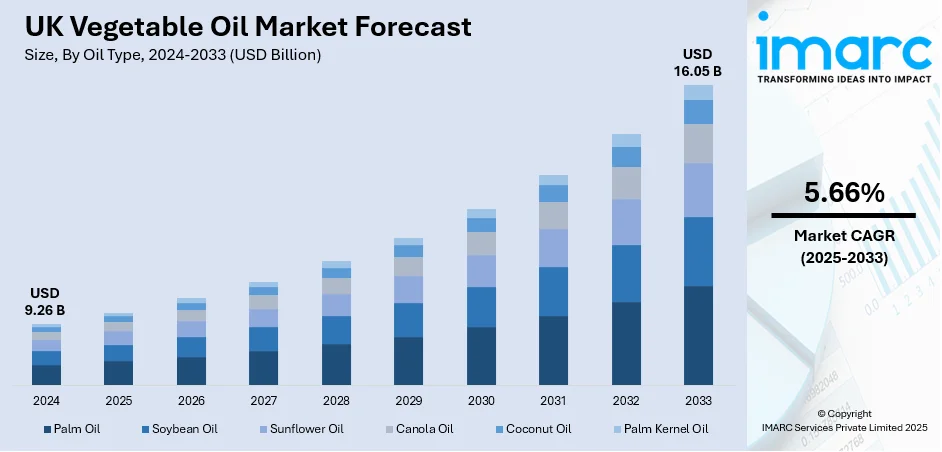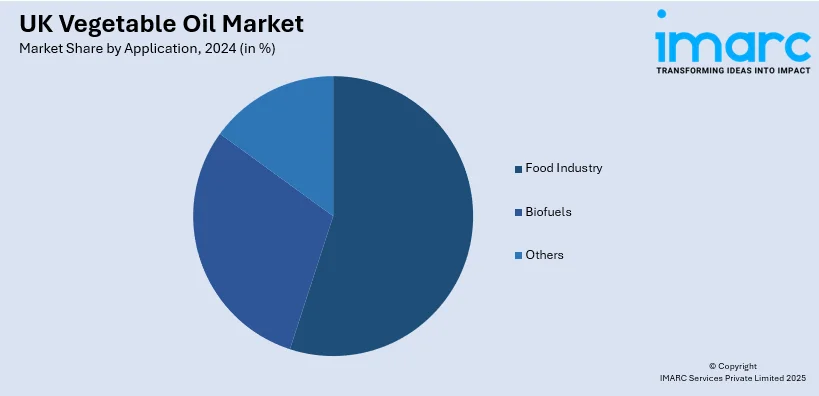
UK Vegetable Oil Market Size, Share, Trends and Forecast by Oil Type, Application, and Region, 2025-2033
UK Vegetable Oil Market Overview:
The UK vegetable oil market size reached USD 9.26 Billion in 2024. Looking forward, the market is projected to reach USD 16.05 Billion by 2033, exhibiting a growth rate (CAGR) of 5.66% during 2025-2033. The market is driven by increased consumer preference for plant-based and sustainable oils across food applications. Vegetable oils are also integral to renewable fuel mandates and circular economy strategies involving waste oil recovery. Strengthened agricultural subsidies, food safety regulations, and local sourcing initiatives are further augmenting the UK vegetable oil market share.
|
Report Attribute
|
Key Statistics
|
|---|---|
|
Base Year
|
2024 |
|
Forecast Years
|
2025-2033
|
|
Historical Years
|
2019-2024
|
| Market Size in 2024 | USD 9.26 Billion |
| Market Forecast in 2033 | USD 16.05 Billion |
| Market Growth Rate 2025-2033 | 5.66% |
UK Vegetable Oil Market Trends:
Shift Toward Sustainable and Plant-Based Diets
In the UK, rising consumer demand for plant-based foods and clean-label products has significantly increased the use of vegetable oils such as rapeseed, sunflower, and olive oil in both home and industrial food applications. Public health campaigns emphasizing reduced saturated fat consumption, alongside flexitarian diets, have led manufacturers to reformulate processed foods with healthier oil alternatives. The growth of vegan-ready meals, plant-based dairy substitutes, and non-dairy spreads relies heavily on stable vegetable oil supply. Local rapeseed oil, often marketed as a low-saturated fat and British-grown alternative to imported oils, is increasingly favored by food manufacturers and restaurants. The UK still maintained a domestic oilseed rape production of 756,000 tons in 2024 despite adverse weather conditions. Additionally, sustainability-focused consumers are seeking cold-pressed, organic, and non-GMO oil varieties. Retailers have responded with dedicated shelf space and private-label vegetable oil products catering to eco-conscious households. As the government promotes sustainable farming and clean eating through initiatives such as the National Food Strategy, vegetable oils are becoming integral to the nutritional transition underway in the UK. This alignment with food system reform and consumer values directly supports UK vegetable oil market growth and expands the sector’s relevance beyond traditional culinary functions.

To get more information on this market, Request Sample
Regulatory Standards and Domestic Agricultural Support
The UK’s vegetable oil sector operates under strict food safety and labeling regulations that ensure product integrity across food and fuel segments. Post-Brexit, the UK government has introduced localized agricultural subsidies and trade protections for oilseed crops, especially rapeseed, to strengthen domestic supply chains. In 2023, the UK exported oils worth £0.7 Billion (approximately USD 889 Million) and achieved a 62% food self-sufficiency ratio overall and 75% for indigenous-type food, which includes crops like oilseed rape. This indicates a relatively strong domestic production capability for native crops. These incentives aim to reduce dependence on volatile imports and support British farmers facing reduced EU market access. Meanwhile, food labeling standards around allergens, nutritional claims, and origin declarations have increased consumer trust in vegetable oil products. Supermarkets have adopted clearer front-of-pack labeling, emphasizing high oleic, low saturated fat, or non-hydrogenated vegetable oil content. Importantly, regulatory scrutiny around palm oil sourcing and deforestation risks has led food processors to substitute with locally sourced or certified oils. The rise in traceability demands from both consumers and regulators incentivizes investment in clean, sustainable, and transparently processed oils. Collectively, these policies not only stabilize domestic vegetable oil production but also enhance product differentiation in the UK’s competitive retail and food service landscape. As standards tighten and local farming gains strategic backing, the regulatory environment continues to reinforce the sector’s market potential.
UK Vegetable Oil Market Segmentation:
IMARC Group provides an analysis of the key trends in each segment of the market, along with forecasts at the country and regional levels for 2025-2033. Our report has categorized the market based on oil type and application.
Oil Type Insights:
- Palm Oil
- Soybean Oil
- Sunflower Oil
- Canola Oil
- Coconut Oil
- Palm Kernel Oil
The report has provided a detailed breakup and analysis of the market based on the oil type. This includes palm oil, soybean oil, sunflower oil, canola oil, coconut oil, and palm kernel oil.
Application Insights:

- Food Industry
- Biofuels
- Others
The report has provided a detailed breakup and analysis of the market based on the application. This includes food industry, biofuels, and others.
Regional Insights:
- London
- South East
- North West
- East of England
- South West
- Scotland
- West Midlands
- Yorkshire and The Humber
- East Midlands
- Others
The report has also provided a comprehensive analysis of all major regional markets. This includes London, South East, North West, East of England, South West, Scotland, West Midlands, Yorkshire and The Humber, East Midlands, and Others.
Competitive Landscape:
The market research report has also provided a comprehensive analysis of the competitive landscape. Competitive analysis such as market structure, key player positioning, top winning strategies, competitive dashboard, and company evaluation quadrant has been covered in the report. Also, detailed profiles of all major companies have been provided.
UK Vegetable Oil Market Report Coverage:
| Report Features | Details |
|---|---|
| Base Year of the Analysis | 2024 |
| Historical Period | 2019-2024 |
| Forecast Period | 2025-2033 |
| Units | Billion USD |
| Scope of the Report | Exploration of Historical Trends and Market Outlook, Industry Catalysts and Challenges, Segment-Wise Historical and Future Market Assessment:
|
| Oil Types Covered | Palm Oil, Soybean Oil, Sunflower Oil, Canola Oil, Coconut Oil, Palm Kernel Oil |
| Applications Covered | Food Industry, Biofuels, Others |
| Regions Covered | London, South East, North West, East of England, South West, Scotland, West Midlands, Yorkshire and The Humber, East Midlands, Others |
| Customization Scope | 10% Free Customization |
| Post-Sale Analyst Support | 10-12 Weeks |
| Delivery Format | PDF and Excel through Email (We can also provide the editable version of the report in PPT/Word format on special request) |
Key Benefits for Stakeholders:
- IMARC’s industry report offers a comprehensive quantitative analysis of various market segments, historical and current market trends, market forecasts, and dynamics of the UK vegetable oil market from 2019-2033.
- The research report provides the latest information on the market drivers, challenges, and opportunities in the UK vegetable oil market.
- Porter's five forces analysis assist stakeholders in assessing the impact of new entrants, competitive rivalry, supplier power, buyer power, and the threat of substitution. It helps stakeholders to analyze the level of competition within the UK vegetable oil industry and its attractiveness.
- Competitive landscape allows stakeholders to understand their competitive environment and provides an insight into the current positions of key players in the market.
Key Questions Answered in This Report
The UK vegetable oil market was valued at USD 9.26 Billion in 2024.
The UK vegetable oil market is projected to exhibit a CAGR of 5.66% during 2025-2033, reaching a value of USD 16.05 Billion by 2033.
The UK vegetable oil market is driven by rising health awareness, growing demand for plant-based diets, and increased usage in food processing and home cooking. Consumers also prefer oils with perceived health benefits like rapeseed and sunflower. Sustainability concerns further influence choices, boosting interest in responsibly sourced and eco-friendly oil products.
Need more help?
- Speak to our experienced analysts for insights on the current market scenarios.
- Include additional segments and countries to customize the report as per your requirement.
- Gain an unparalleled competitive advantage in your domain by understanding how to utilize the report and positively impacting your operations and revenue.
- For further assistance, please connect with our analysts.
 Request Customization
Request Customization
 Speak to an Analyst
Speak to an Analyst
 Request Brochure
Request Brochure
 Inquire Before Buying
Inquire Before Buying




.webp)




.webp)












